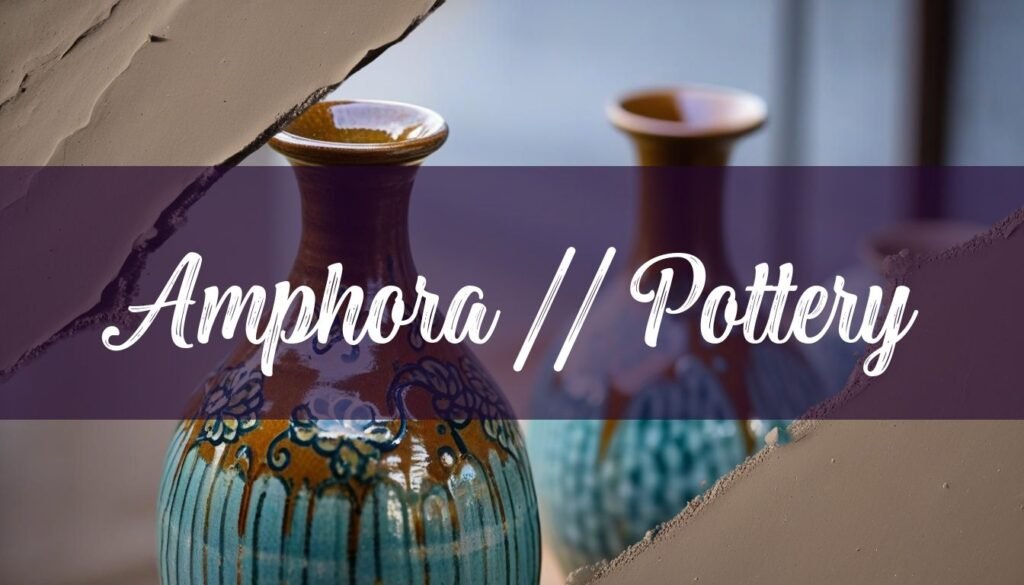Amphora pottery, a hallmark of ancient Mediterranean cultures, stands as a testament to the ingenuity and artistry of potters from millennia ago. Defined as a two-handled pot with a neck narrower than its body, the amphora (plural: amphorae) served as a ubiquitous storage and transport vessel. Its prevalence in archaeological sites across the region speaks volumes about its integral role in the economic and cultural exchange of the ancient world. From humble, undecorated workhorses of maritime trade to elaborately painted prizes in athletic games, amphorae embody a diverse range of functions and aesthetic styles, offering invaluable insights into ancient life. These vessels, crafted from simple clay, have transcended their utilitarian origins to become enduring symbols of ancient commerce, artistic expression, and cultural identity. Their survival in great numbers is also the result of a much wider reliance on pottery vessels in a period when other materials were expensive or unknown.
The evolution of the amphora can be traced from its early, more rudimentary forms to the standardized shapes that became characteristic of Greek and Roman pottery. The Greeks, renowned for their pottery, developed distinct types such as the neck amphora, where the neck meets the body at a sharp angle, and the one-piece amphora, featuring a continuous curve from lip to foot. The neck amphora was common from the Geometric period (c. 900 bc) to the decline of Greek pottery; the one-piece amphora appeared in the 7th century bc. Among the neck amphorae, several variations existed, including the Nolan amphora with its high neck, often adorned with triple handles in the red-figure style, and the Panathenaic amphora, exclusively decorated in black-figure and awarded as prizes in the Panathenaic Games.
These prize amphorae, filled with olive oil and bearing the inscription “I am one of the prizes from Athens,” provide a glimpse into the athletic and cultural values of the time. The one-piece amphora, in contrast, maintained a more consistent shape with its cylindrical handles, flaring lip, and ample belly, showcasing a different aesthetic sensibility. Similarly, the walls were divided into zones with the scenes portrayed one after another with no interruptions. To learn more about pottery from this period, check out this article on
ancient Greek pottery.
Materials, Manufacturing, and Decoration
The creation of an amphora was a meticulous process, beginning with the selection and preparation of clay. Potters often sourced clay locally, resulting in variations in color and composition depending on the region. The clay would then be levigated, a process of mixing it with water and allowing it to settle, removing impurities and refining its texture. Once the clay reached the desired consistency, it was wedged to remove air bubbles and align the clay particles, enhancing its plasticity. The amphora itself was typically formed on a potter’s wheel, a technique known as throwing.
The potter would skillfully shape the clay, creating the characteristic narrow neck, wide body, and handles of the amphora. After the vessel had dried to a leather-hard state, it was trimmed to refine its shape and appendages like handles and lids were added. Finally, the amphora was fired in a kiln at high temperatures, transforming the clay into a hard, durable ceramic. Ceramic vessels survive for thousands of years because they are fired in kilns at high temperatures which transforms clay into a hard, rock-like material that is resistant to corrosion and decomposition. To further explore these techniques, consider reading about
centering clay.
Decoration played a significant role in the aesthetic and symbolic value of amphorae. While some amphorae remained undecorated, particularly those used for basic transport, many were adorned with intricate painted scenes and motifs. The Greeks were masters of vase painting, employing techniques such as black-figure and red-figure to depict mythological narratives, scenes from daily life, and athletic contests. In black-figure pottery, figures were painted in black slip against the reddish background of the clay, with details incised to reveal the clay beneath.
Red-figure pottery, a later innovation, reversed this process, with figures rendered in the natural reddish color of the clay against a black background, allowing for greater detail and naturalism. The subjects depicted on amphorae often carried symbolic meanings, reflecting the cultural values and beliefs of the time. For example, equine themes alluded to the prestige of horse ownership and the concept of regeneration, while scenes from mythology conveyed moral lessons and religious narratives. Decoration of other objects was not only reduced to black and red, as in pottery, but some figures were colored.
Amphorae in Trade and Commerce
Beyond their artistic and cultural significance, amphorae played a pivotal role in ancient trade and commerce. Their primary function was to transport and store a variety of goods, including liquids such as wine, olive oil, and fish sauces, as well as dry goods like grain and olives. The shape and design of amphorae were specifically adapted for maritime transport, with their pointed bases allowing them to be securely stacked in the holds of ships. The handles facilitated lifting and carrying, while the narrow necks helped to prevent spillage. The distribution of amphorae across the Mediterranean and beyond provides valuable evidence of ancient trade routes and economic activity. The presence of amphorae from specific regions at archaeological sites indicates the origin of the goods being traded and the extent of the trade networks.
The study of amphorae has allowed archaeologists to reconstruct patterns of production, consumption, and exchange, shedding light on the economic dynamics of the ancient world. Many amphorae had stamps or inscriptions that indicated the producer, origin, and type of contents.
Amphora pottery, therefore, represents far more than just a vessel. It is a multifaceted artifact that encapsulates the artistic, cultural, and economic life of ancient societies. From their humble origins as utilitarian containers to their elaborate decoration and symbolic significance, amphorae offer a window into the past, providing invaluable insights into the world of the ancient Mediterranean. Their enduring presence in museums and archaeological collections around the world serves as a testament to their enduring legacy and their continued importance as objects of study and appreciation.





